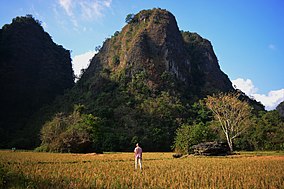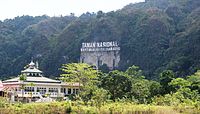
Sulawesi, also known as Celebes, is an island in Indonesia. One of the four Greater Sunda Islands, and the world's 11th-largest island, it is situated east of Borneo, west of the Maluku Islands, and south of Mindanao and the Sulu Archipelago. Within Indonesia, only Sumatra, Borneo, and Papua are larger in territory, and only Java and Sumatra are more populous.
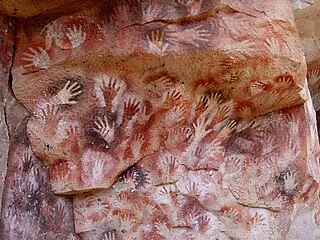
In archaeology, cave paintings are a type of parietal art, found on the wall or ceilings of caves. The term usually implies prehistoric origin. These paintings were often created by Homo sapiens, but also Denisovans and Neanderthals; other species in the same Homo genus. Discussion around prehistoric art is important in understanding the history of the Homo sapiens species and how Homo sapiens have come to have unique abstract thoughts. Some point to these prehistoric paintings as possible examples of creativity, spirituality, and sentimental thinking in prehistoric humans.
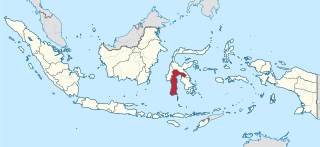
South Sulawesi is a province in the southern peninsula of Sulawesi, Indonesia. The Selayar Islands archipelago to the south of Sulawesi is also part of the province. The capital and largest city is Makassar. The province is bordered by Central Sulawesi and West Sulawesi to the north, the Gulf of Bone and Southeast Sulawesi to the east, Makassar Strait to the west, and Flores Sea to the south.
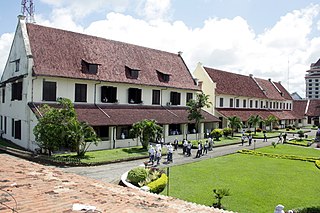
Makassar, formerly Ujung Pandang, is the capital of the Indonesian province of South Sulawesi. It is the largest city in the region of Eastern Indonesia and the country's fifth-largest urban center after Jakarta, Surabaya, Medan, and Bandung. The city is located on the southwest coast of the island of Sulawesi, facing the Makassar Strait.

The Moor macaque is a macaque monkey with brown/black body fur with a pale rump patch and pink bare skin on the rump. It has ischial callosities, which are oval-shaped. It is about 50–58.5 cm long, and eats figs, bamboo seeds, buds, sprouts, invertebrates and cereals in tropical rainforests. It is sometimes called "dog-ape" because of its dog-like muzzle, although it is no more closely related to apes than any other Old World monkey is. It is endemic to the island of Sulawesi in Indonesia, which is an important biodiversity hotspot.

Maros is a town in the South Sulawesi province of Indonesia close to the provincial capital of Makassar. It is the capital of the Maros Regency.

The Indonesian archipelago is a vast and diverse collection of over 17,000 to 18,000 islands located between the Indian and Pacific Oceans in Southeast Asia and Oceania. It is the world's largest archipelago, with five main islands—Sumatra, Java, Borneo, Sulawesi, and New Guinea. The Indonesian archipelago is known for its rich biodiversity, unique wildlife, and varied ecosystems, ranging from tropical rainforests to active volcanoes. The archipelago boasts a diverse cultural heritage, with thousands of ethnic groups and languages. Its strategic location and natural resources have made it a historically significant trade hub and a key player in regional and global affairs. Historically, the Indonesian archipelago was influenced by various cultures and empires, including Hindu and Buddhist kingdoms, Islamic sultanates, and European colonial powers, before gaining independence in 1945 as the state of "Indonesia".

Troides criton, the Criton birdwing, is a birdwing butterfly found on the islands of Morotai, Halmahera, Bali, Bacan, Ternate and Obi in Indonesia.

Gowa is a regency in the province of South Sulawesi, Indonesia. It has an area of 1,883.33 km2 and a population of 652,329 at the 2010 census, increasing to 765,836 at the 2020 census; the official estimate at mid-2023 was 799,999. The majority of the regency lies within the official metropolitan area of the city of Makassar, including the regency's administrative capital at Sungguminasa. The hill resort of Malino is in the eastern (non-metropolitan) part of the regency.

Papilio blumei, the greenpeacock or green swallowtail, is a butterfly of the family Papilionidae. It is found only on the Indonesian island of Sulawesi. It is sometimes confused with the more widespread P. palinurus, but that species is smaller and has mostly black tails.

Maros Regency is a regency of South Sulawesi province of Indonesia. It covers an area of 1,619.12 sq.km, and had a population of 319,002 at the 2010 Census and 391,774 at the Census of 2020. The official population estimate for mid-2023 was 407,920 according the Province's official estimates but only 389,277 according to the Regency's official estimates. Almost all of the regency lies within the official metropolitan area of the city of Makassar. The administrative centre of the regency is the town of Maros.

Sidenreng Rappang Regency is a landlocked regency of South Sulawesi Province in Indonesia. It has an area of 1,883.23 kilometres (1,170.18 mi) and had a population of 271,911 at the 2010 Census and 319,990 at the 2020 Census; the official estimate as at mid 2023 was 326,330. Its capital is at the town of Pangkajene Sidenreng. The original inhabitants of this area are Bugis.

Papilio sataspes is a species of swallowtail butterfly from the genus Papilio that is found in Sulawesi and Banggai.

The caves in the Maros-Pangkep karst are situated in South Sulawesi, Indonesia, and contain paintings from the Paleolithic considered to be the earliest figurative art in the world, dated to at least 43,900 years ago.
Bostrychus microphthalmus is a species of fish from the family Butidae. It is endemic to Maros karst in southern Sulawesi, Indonesia. It was the first documented cave-dwelling fish in Sulawesi, but since then the brotula Diancistrus typhlops has been described from nearby Muna Island, and an additional apparently undescribed eleotrid is known from Sulawesi's Maros karst.

The Toalean people were hunter-gatherers who inhabited the Indonesian island of Sulawesi during the Mid- to Late-Holocene period prior to the spread of Austronesian Neolithic farmers some 3,500 years ago from mainland Asia.
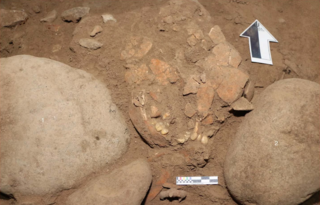
Besséʼ is the prehistoric fossil of a young woman over 7,200 years old found in the Indonesian island of Sulawesi. Discovered at Leang Panninge at the Maros Regency by archaeologists from the University of Hasanuddin in 2015, its formal description including genome sequencing was published in Nature in 2021. As the first human remain discovered belonging to the Toalean people, it provides critical understanding to human culture and migration during the Holocene period of Asia. The nickname is adopted from the Bugis's custom of affectionately calling their newborn baby girls.
Leang Karampuang, also known as Karampuang cave, is a prehistoric archaeological site within the Maros-Pangkep Karst hills of Bantimurung-Bulusaraung National Park, situated administratively in Samangki Village, Simbang District, Maros Regency, South Sulawesi, Indonesia.
